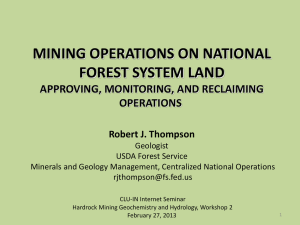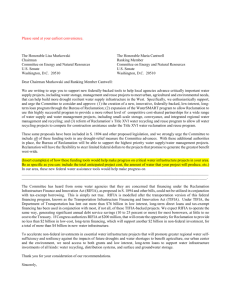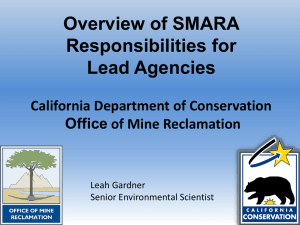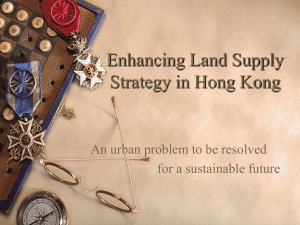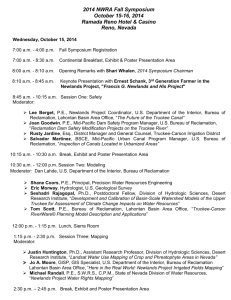JASMR-Issue 1
advertisement
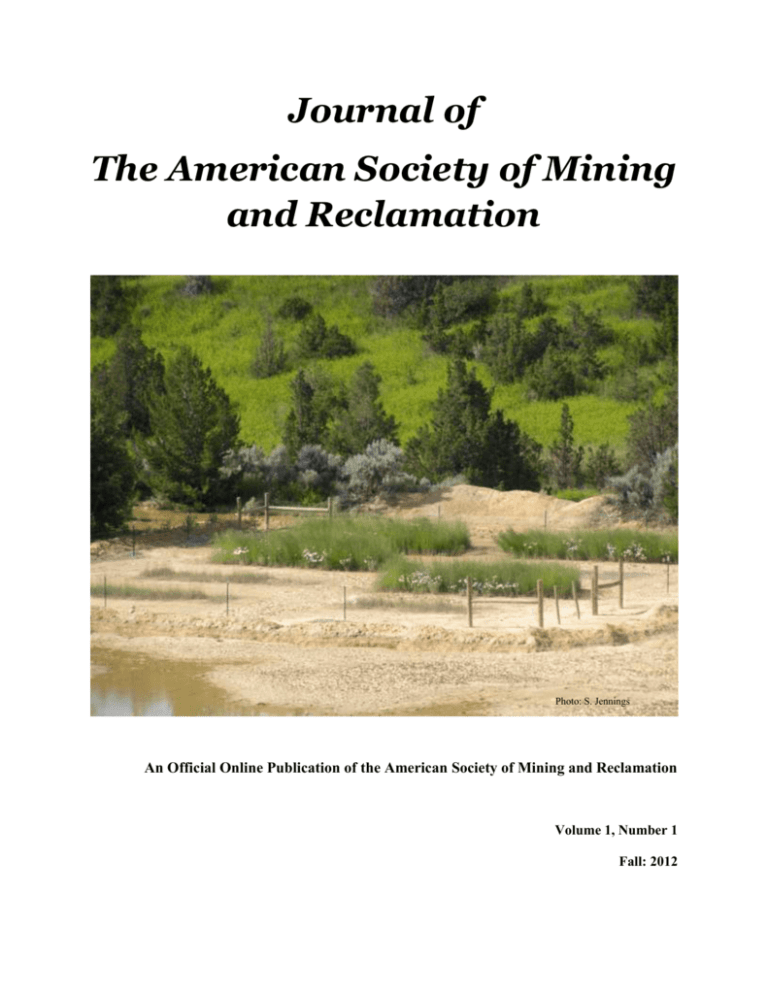
Journal of The American Society of Mining and Reclamation Photo: S. Jennings An Official Online Publication of the American Society of Mining and Reclamation Volume 1, Number 1 Fall: 2012 JASMR Vol.1, No.1 JASMR Editorial Board Dr. Robert Darmody Dr. Jeff Skousen Dr. Gerard Schuman Dr. George Vance Editor-in-Chief: Dr. Richard I. Barnhisel Journal of the American Society of Mining and Reclamation The Journal of the American Society of Mining and Reclamation promotes the exchange of basic and applied solutions for the reclamation, restoration, and revitalization of landscapes impacted by the extraction of natural resources—including, but not limited to coal, minerals, gas, and oil. Contributions reporting original research, case studies, field demonstrations, or policy dealing with some aspect of ecosystem reclamation are accepted from all disciplines for consideration by the editorial board. Contributions to JASMR Associate Editors: Dr. Fred Brenner, Grove City College Dr. Suzette Burckhard S Dakota State University Dr. Jon Bryan Burley, Michigan State University Dr. W. Lee Daniels, Virginia Tech Dr. Jennifer Franklin. University of Tennessee Dr. Gwen Geidel, University of South Carolina Mr. Christopher Johnston Inter-Mountain Labs Dr. Louis McDonald, West Virginia University Mr. Dennis Neuman, KC Harvey Environmental, Bozeman MT Dr. Peter Stahl, University of Wyoming The Journal of the Society of Mining and Reclamation will be published quarterly online on the Society’s website: www.asmr.us Page charges are $5 US/page for ASMR members and $10 US /page for non-members, payable prior to placement in the web The Journal of the American Society of Mining and Reclamation publishes contributions under the headings Research Papers, Case Studies, Demonstrations, Policy Papers and Review articles. All papers are peer reviewed. Manuscripts may be volunteered, invited, or coordinated as a symposium. Research Papers: Emphasis is given to the understanding of underlying processes rather than to monitoring. Applying these principals to specific, replicated laboratory, glasshouse, and field problems dealing with reclamation are encouraged. These reports are grouped into the following ASMR defined groups: ecology, forestry and wildlife, geotechnical engineering, land use planning and design, international tailings reclamation, soils and overburden, and water management. Case Studies: Papers in this category report on reclamation activities over spatial or temporal scales. Monitoring of the response of ecosystem components (water, soil, and vegetation) to innovative practices are the basis for these case study reports. Demonstration Studies: Papers in this category report on reclamation activities that do not necessarily include projects where significant amounts of data are collected. These may consist of largely photographic evidence of before and after some reclamation technique is applied. These may be observations that practicing reclamationists have observed that have changed how they continued to enhance the process of returning disturbed landscapes to a more desirable condition. Policy or Review Papers: Submission of papers dealing with regulatory and procedural issues is welcomed. These papers emphasize changing approaches to the science and technology of landscape revitalization. Other: Letters to the Editor are accepted, and Book Reviews may be invited by the Editor-in Chief. Paper Submission to JASMR Manuscripts are submitted electronically to Dr. Richard Barnhisel at asmr@twc.com. Style Guide for Authors: Manuscript preparation guide is available at: http://www.asmr.us/Publications/Journal/Manuscript%20Guidelines%20Journal.p df or use https://www.agronomy.org/publications/style ii JASMR Vol.1, No.1 Table of Contents Research Papers SUSTAINABLE LANDSCAPES: EVALUATING STRATEGIES FOR CONTROLLING AUTUMN OLIVE (ELAEAGNUS UMBELLATA) ON RECLAIMED SURFACE MINELAND AT THE WILDS CONSERVATION CENTER IN SOUTHEASTERN OHIO Shana M. Byrd, Nicole D. Cavender, Corine M. Peugh and Jenise M. Bauman. p. 1-9 Click the next link as below to open the respective papers http://www.asmr.us/Publications/Journal/Vol 1 Issue 1/Byrd-OH.pdf COMPARISON OF HYDROLOGIC CHARACTERISTICS FROM TWO DIFFERENTLY RECLAIMED TAILINGS PONDS; GRAVES MOUNTAIN, LINCOLNTON, GA Gwendelyn Geidel. p. 10-26 http://www.asmr.us/Publications/Journal/Vol 1 Issue 1/Geidel-SC.pdf USE OF MODFLOW DRAIN PACKAGE FOR SIMULATING INTER-BASIN TRANSFER OF GROUNDWATER IN ABANDONED COAL MINES Mark D. Kozar and Kurt J. McCoy. p. 27-43 http://www.asmr.us/Publications/Journal/Vol 1 Issue 1/Kozar-WA.pdf EFFECTS OF WYOMING BIG SAGEBRUSH SEEDING RATE AND GRASS COMPETITION ON LONG-TERM DENSITY AND CANOPY VOLUME OF BIG SAGEBRUSH AND WILDLIFE HABITAT G.E. Schuman, M.C. Mortenson, and L.E. Vicklund. p. 44-55 http://www.asmr.us/Publications/Journal/Vol 1 Issue 1/Schuman-WY.pdf YOUNG FOREST COMPOSITION AND GROWTH ON A RECLAIMED APPALACHIAN COAL SURFACE MINE AFTER NINE YEARS C.E. Zipper, J.A. Burger, D.M. Evans, and P. Donovan. p. 56-84 http://www.asmr.us/Publications/Journal/Vol 1 Issue 1/Zipper-VA.pdf Case Studies ACHIEVING RECLAMATION SUCCESS GLOBALLY – PEABODY ENERGY'S EXPERIENCE IN MONGOLIA V. R. Pfannenstiel and Davganamdal Tumenjargal. p. 85-102 http://www.asmr.us/Publications/Journal/Vol 1 Issue 1/Pfannenstiel-AZ.pdf iii JASMR Vol.1, No.1 Demonstration Papers This issue of JASMR does not have any Demonstration Papers. Other Papers Including Review Papers IN SITU COAL GASIFICATION: AN EMERGING TECHNOLOGY Kristin M. Brown p. 103-122 http://www.asmr.us/Publications/Journal/Vol 1 Issue 1/Brown-CO.pdf A BRIEF HISTORY OF THE AMERICAN SOCIETY OF MINING AND RECLAMATION Jeff Skousen and Dick Barnhisel. p. 123-128 http://www.asmr.us/Publications/Journal/Vol 1 Issue 1/Skousen-WV.pdf iv JASMR Vol.1, No.1 ABSTRACTS OF PAPERS RESEARCH PAPER SUSTAINABLE LANDSCAPES: EVALUATING STRATEGIES FOR CONTROLLING AUTUMN OLIVE (ELAEAGNUS UMBELLATA) ON RECLAIMED SURFACE MINELAND AT THE WILDS CONSERVATION CENTER IN SOUTHEASTERN OHIO1 Shana M. Byrd2, Nicole D. Cavender, Corine M. Peugh and Jenise M. Bauman Abstract: Autumn olive (Elaeagnus umbellata) was planted during the reclamation process to reduce erosion and improve nitrogen content of the soil. However, since its establishment, E. umbellata has spread prolifically and control measures are difficult. The primary objective of this case study was to evaluate the effectiveness of various control methods on eradication of E. umbellata in varying degrees of infestation. A twophase case study was conducted at The Wilds conservation center in Cumberland, OH. Phase 1 began in 2007-2008 to evaluate three treatments in areas with moderate cover (15-30%) of E. umbellata: mechanical removal, foliar herbicide, and dormant stem herbicide. Nine 200m2 study plots were established with three replications of each treatment. Effectiveness of each treatment was evaluated in 2009 through tracking 225 individual shrubs. The foliar herbicide controlled 98% of E. umbellata; dormant stem herbicide achieved 71 % and the mechanical treatment controlled only 15 %. Statistical comparisons indicated the foliar and dormant stem herbicides were more effective (P = 0.0008) than mechanical removal. This suggests that foliar applications can be a reliable tool for control of E. umbellata in areas with a 15-30 % density level. Based on these findings, phase 2 of this study was initiated in 2010 to evaluate removal techniques in dense shrub infestations (95-100 %). Treatments included a combination of mechanical clearing then a chemical treatment of stumps to reduce re-sprouts. The fracture treatment was most effective during the second phase (63 %), when compared to the cut-stump (46 %) mechanical treatment (P = 0.004). Results demonstrate that a combined mechanicalchemical approach is efficient in dense infestations. Mechanical land clearing through fracture and re-sprout treatment appeared to be most effective in E. umbellata control and the most cost effective in dense cover; however replicated studies are needed to provide conclusive information about the fracture re-sprout treatment. Additional Key Words: invasive species, landscape management, grassland bird habitat, native plant restoration ___________________________ 1 Paper was presented at the 2012 National Meeting of the American Society of Mining and Reclamation, Tupelo, MS. Sustainable Reclamation June 8 – 15, 2012 and accepted for the online publication in the Journal of The American Society of Mining and Reclamation, Volume 1, No. 1, 2012. R.I. Barnhisel (Ed.) Published by ASMR, 3134 Montavesta Rd., Lexington, KY 40502. 2 Shana Byrd is Restoration Ecology Program Director, The Wilds, Cumberland, OH 43732; Nicole Cavender is Vice President, Science and Conservation, The Morton Arboretum, Lisle, IL 60532; Corine Peugh is Restoration Ecology Project Manager, The Wilds, Cumberland, OH 43732; and Jenise Bauman is Professor and Research Associate, Miami University, Oxford, Ohio 45056. http://www.asmr.us/Publications/Journal/Vol 1 Issue 1/Byrd-OH.pdf . v JASMR Vol.1, No.1 RESEARCH PAPER COMPARISON OF HYDROLOGIC CHARACTERISTICS FROM TWO DIFFERENTLY RECLAIMED TAILINGS PONDS; GRAVES MOUNTAIN, LINCOLNTON, GA1 Gwendelyn Geidel2 Abstract: This study compares and evaluates the hydrologic characteristics between two kyanite ore process tailings ponds that were reclaimed with different reclamation strategies; one reclaimed with an impermeable membrane and the other with an open, surface reconfiguration (OSR) methodology. During the extraction and processing of kyanite ore from the Graves Mountain mine, Lincoln County, Georgia, fine grained tailings were produced. The tailings were transported by slurry pipeline to various tailings ponds which were created by the construction of dams using on-site materials. The first study site, referred to as the Pyrite Pond (PP), was constructed and filled during the 1960’s and early 1970’s. In early 1992, the PP was capped with an impermeable membrane, covered with a thin soil veneer and vegetated and in 1998 the upslope reclamation was completed. The second tailings pond, referred to as the East Tailings Pond (ETP), was constructed and filled in the 1970’s and early 1980’s and was reclaimed in 1995-96 by surface reconfiguration and the addition of soil amendments. Piezometers and wells were installed into the two tailings ponds and also in close proximity to the tailings ponds. While the initial study was aimed at comparing the two reclamation strategies, it became apparent that the ground water was a dominant factor. Results of the evaluation of the potentiometric surface data for varying depths within each tailings pond indicate that while both tailings ponds exhibit delayed response to precipitation events suggesting infiltration effects, the delay in the ETP deep wells and PP wells could not be adequately described by a surface infiltration model. Further consideration of the surrounding well data, coupled with the tailings cross sections and water levels, suggest that the hydrologic characteristics of both tailings ponds are significantly influenced by base flow infiltration and ground water seepage into the upgradient areas of the tailing ponds. Additional Key Words: acid mine drainage, acid rock drainage, dry cover, impermeable cover, permeable cover. ___________________ 1 Paper was presented at the 2012 National Meeting of the American Society of Mining and Reclamation, Tupelo, MS Sustainable Reclamation June 8 – 15, 2012, and accepted for the online publication in the Journal of The American Society of Mining and Reclamation, Volume 1, No. 1, 2012.R.I. Barnhisel (Ed.) Published by ASMR, 3134 Montavesta Rd., Lexington, KY 40502 2 Gwendelyn Geidel is Research Professor in the School of the Earth, Ocean, and Environment, University of South Carolina, Columbia, SC 29208. http://www.asmr.us/Publications/Journal/Vol 1 Issue 1/Geidel-SC.pdf vi JASMR Vol.1, No.1 RESEARCH PAPER USE OF MODFLOW DRAIN PACKAGE FOR SIMULATING INTER-BASIN TRANSFER OF GROUNDWATER IN ABANDONED COAL MINES1 Mark D. Kozar2 and Kurt J. McCoy Abstract. Simulation of groundwater flow in abandoned mines is difficult, especially where flux to and from mines is unknown or poorly quantified, and inter-basin transfer of groundwater occurs. A study was conducted in southernmost WV to better understand inter-basin transfer of groundwater in above-drainage abandoned coal mines. The Elkhorn area was specifically selected, as all mines are located above the elevation of tributary receiving streams, to allow accurate measurements of discharge from mine portals and tributaries for groundwater model calibration. Abandoned mine workings were simulated initially as a layer of high hydraulic conductivity bounded by lower permeability rock in adjacent strata, and secondly as rows of higher hydraulic conductivity embedded within a lower hydraulic conductivity coal aquifer matrix. Regardless of the hydraulic conductivity assigned to mine workings, neither approach to simulate mine workings could accurately estimate inter-basin transfer of groundwater from the adjacent Bluestone River Watershed. To resolve the problem, a third approach was developed. The MODFLOW DRAIN package was used to simulate seepage into and through mine workings discharging water under unconfined conditions to Elkhorn Creek, North Fork, and tributaries of the Bluestone River. Drain nodes were embedded in a matrix of uniform hydraulic conductivity cells that represented the coal mine aquifer. Drain heads were empirically defined from well observations, and elevations were based on structure contours for the Pocahontas No. 3 mine workings. Use of the DRAIN package to simulate mine workings as an internal boundary condition resolved the inter-basin transfer problem, and effectively simulated a shift from a topographic- dominated to a dip-dominated flow system, by dewatering overlying un-mined strata and shifting the groundwater drainage divide up dip within the Pocahontas No. 3 coal seam approximately five kilometers into the adjacent Bluestone River Watershed. The simulation of mine entries and discharge using the MODFLOW DRAIN package produced estimated flows of 0.46 and 0.26 m3/s for the Elkhorn Creek and North Fork watersheds respectively, which matched measured flows for the respective watersheds of 0.47 and 0.26 m3/s. Additional Key Words: Groundwater flow, numerical model _________________ 1 Paper presented at the 2012 National Meeting of the American Society of Mining and Reclamation, Tupelo, MS Sustainable Reclamation June 8 - 15, 2012 and accepted for the online publication in the Journal of The American Society of Mining and Reclamation, Volume 1, No. 1, 2012. R.I. Barnhisel (Ed.) Published by ASMR, 3134 Montavesta Rd., Lexington, KY 40502. 2 Mark D. Kozar is a Hydrologist with the U.S. Geological Survey, Washington Water Science Center, Tacoma, WA 98402; Kurt J. McCoy is a Hydrologist with the U.S. Geological Survey, Virginia Water Science Center, Richmond, VA 23228. http://www.asmr.us/Publications/Journal/Vol 1 Issue 1/Kozar-WA.pdf vii JASMR Vol.1, No.1 RESEARCH PAPER EFFECTS OF WYOMING BIG SAGEBRUSH SEEDING RATE AND GRASS COMPETITION ON LONG-TERM DENSITY AND CANOPY VOLUME OF BIG SAGEBRUSH AND WILDLIFE HABITAT1 G.E. Schuman2, M.C. Mortenson, and L.E. Vicklund Abstract: This research was initiated in 1997 to evaluate the effects of seeding rates of grass and Wyoming big sagebrush on the establishment of big sagebrush. The research was accomplished at the Belle Ayr West mine, south of Gillette, WY using a randomized complete block with three big sagebrush seeding rates (1, 2, and 4 kg PLS /ha) and seven grass seeding rates (0, 2, 4, 6, 8, 10, and 14 kg PLS /ha ) experimental design. Field data were collected from 1997-2004 and re-sampled in 2010 to evaluate the long-term effects of these seeding rate treatments on big sagebrush density and plant canopy volume. Wyoming big sagebrush average density decreased by 25-33 % from 2004 to 2010 but the density remained above the 1 plant/m2 level required by regulatory standards. Wyoming big sagebrush average canopy volume in 2010 (per plant) was 15 times greater than observed in 2004. Shrub density, cover, and height met or exceeded the levels recommended for sage grouse and antelope habitat, two primary users of these lands that are a concern to wildlife management agencies and mine regulatory agencies in WY. General sage grouse requirements are 1.5 plants/m2, a shrub height of 18 to 26.6 cm, and shrub cover of 5.5 %. General antelope shrub height requirements are 22 to 46 cm, and cover requirements are 5 to 30 %. This emphasizes the importance of grass and sagebrush seeding rates necessary to achieve these desire goals. Additional Key Words: shrub establishment, mined land reclamation, semi-arid region, shrub cover. ________________________ 1 Invited paper, published in the online Journal of The American Society of Mining and Reclamation, Volume 1, No. 1, 2012. 2 Gerald E. Schuman is Soil Scientist, Collaborator (retired), High Plains Grasslands Research Station, USDA, ARS, Cheyenne, WY 82009 and Adjunct Professor, Dept. of Ecosystems Science and Management, University of WY, Laramie, WY 82071; Matthew C. Mortenson is Physical Science Technician, High Plains Grasslands Research Station, USDA, ARS, Cheyenne, WY 82009; Laurel E. Vicklund, is Senior Environmental Scientist, Peabody Powder River Operations, LLC., Gillette, WY 82717; http://www.asmr.us/Publications/Journal/Vol 1 Issue 1/Schuman-WY.pdf viii JASMR Vol.1, No.1 RESEARCH PAPER YOUNG FOREST COMPOSITION AND GROWTH ON A RECLAIMED APPALACHIAN COAL SURFACE MINE AFTER NINE YEARS1 C.E. Zipper2, J.A. Burger, D.M. Evans, P. Donovan Abstract: A 29-ha mine site in Buchanan County, VA, was reclaimed using methods intended to produce favorable conditions for reforestation and planted with forest trees in early 2002. After soil grading, the site was mapped for forest site quality considering rock type, aspect, and soil compaction. Trees of eleven species and one shrub species were prescribed for planting as four species mixes, each targeted for conditions on different locations within the mine site. In 2010, 68 measurement plots, each 0.01 ha in size, were established on a gridded pattern. Within each, soils were characterized and living trees and shrubs were measured for breast-height diameter and height. Data were analyzed to assess density and volume, overall and by species, and to evaluate how these metrics responded to soil and site conditions. After nine growing seasons, 24 tree and three shrub species were recorded as growing on the site; most living trees were non-planted native species. Prominent volunteers were black locust (Robinia pseudoacacia), sourwood (Oxydendrum arboreum), and sweet birch (Betula lenta); prominent planted species were ash (Fraxinus spp.), white oak (Quercus alba), and American sycamore (Platanus occidentalis). Volunteers established and grew best on more acidic soils, on sloped areas where soils were not compacted, and on areas rated as having higher forest site quality. Community composition and volume also varied with these site features. Planted trees’ species composition varied with planting mix and site conditions. On non-compacted soil areas, planted trees’ overall density and volume metrics exhibited few differences that were directly related to site conditions, in part because species selected for and planted preferentially on areas with soil properties poorly suited for most native trees were able to establish and grow. Additional Key Words: Afforestation, reforestation, ecosystem restoration ___________________ 1 Paper was presented at the 2012 National Meeting of the American Society of Mining and Reclamation, Tupelo, MS Sustainable Reclamation June 8 – 15, 2012 and accepted for publication in the Journal of The American Society of Mining and Reclamation, Volume 1, No. 1. R.I. Barnhisel (Ed.) Published by ASMR, 3134 Montavesta Rd., Lexington, KY 40502 2 C.E. Zipper is corresponding author and Professor, D.M. Evans is Research Associate, and Patricia Donovan is GIS Lab Manager, Department of Crop and Soil Environmental Sciences; J.A. Burger is Professor Emeritus, Forest Resources and Environmental Conservation. VA Tech, Blacksburg, VA 24061 http://www.asmr.us/Publications/Journal/Vol 1 Issue 1/Zipper-VA.pdf ix JASMR Vol.1, No.1 CASE STUDIES ACHIEVING RECLAMATION SUCCESS GLOBALLY – PEABODY ENERGY'S EXPERIENCE IN MONGOLIA1 V. R. Pfannenstiel2 and Davganamdal Tumenjargal Abstract: The Ereen Coal Mine operated as a Peabody joint venture project in Mongolia, suspended operations in early 2009. Peabody developed a reclamation and environmental stewardship plan for the site which was initiated in spring 2009. The project would also fulfill the spirit and intent of the 2006 Mongolian Minerals Law. Project development included analysis of environmental baseline conditions and application of best reclamation practices necessary to create a non-erosive and sustainable landform, establish perennial vegetation and restore traditional land use. Mongolian scientists and engineers from Ulaanbaatar teamed with U.S. Peabody engineering and environmental staff to develop and implement a plan to meet Mongolian regulatory requirements and restore pre-mine land capability. The mine area, out-of-pit dumps and adjacent undisturbed lands were surveyed to develop a post-mining landscape design to establish through drainage and return a stable landform. Backfill material was sampled to identify any spoil that could be unsuitable for plant growth or acid forming. Backhoes, trucks and dozers accomplished the backfilling, final grading and replacing a 20 centimeter topsoil depth. Analysis of adjacent native vegetation was used to develop a seed mix of four native species. Ground water encountered was traced to an alluvial system allowing development of a well and pond for domestic and livestock use. The project was partially completed in 2009, with final topsoiling and seeding in summer 2010. The Mongolian work force spearheaded on-site management and field implementation, including use of a new type of seeder. A management and monitoring plan was implemented. Monitoring results show excellent perennial vegetation establishment, 4X the biomass production of the native reference site and more than 20 native species established, all indicative of successful outcomes for the objectives. The project successfully reclaimed the 18 ha site to pre-mine conditions and accomplished the first complete coal mine reclamation project in the history of Mongolia. _______________________ 1 Paper was presented at the 2012 National Meeting of the American Society of Mining and Reclamation, Tupelo, MS Sustainable Reclamation June 8 - 15, 2012 and accepted for publication in the online Journal of The American Society of Mining and Reclamation, Volume 1, No. 1, 2012. R.I. Barnhisel (Ed.) Published by ASMR, 3134 Montavesta Rd., Lexington, KY 40502. 2 Vern. R. Pfannenstiel Peabody Energy, 3001 W. Shamrell Blvd, Flagstaff, AZ 86001, Dr. Davganamdal Tumenjargal School of Natural Sciences, Mongolian State University of Agriculture, Ulaanbaatar, Mongolia http://www.asmr.us/Publications/Journal/Vol 1 Issue 1/Pfannenstiel-AZ.pdf x JASMR Vol.1, No.1 OTHER PAPERS IN SITU COAL GASIFICATION: AN EMERGING TECHNOLOGY1 Kristin M. Brown2 Abstract. A literature review was conducted on in situ coal gasification with particular attention to environmental effects, benefits and process controls of this emerging technology. In situ coal gasification also known as underground coal gasification (UCG) appears to be both technically and economically feasible and exhibits many potential advantages over the conventional mining methods. The resource for UCG is principally un-mined coal seams. The gasification process creates synthesis gas that can be used as fuel, or feedstock for further chemical processes such as NH3 production or liquid fuels. An oxidant (usually air, oxygen, or steam) is injected into the coal seam and reacts with the coal and water present in the seam to produce syngas that is extracted through a production well. As the gasification process proceeds, the cavity grows radially outward and upward from the injection well. UCG has some environmental benefits relative to conventional mining including (1) no discharge of tailings, (2) reduced sulfur emissions (3) reduced discharge of ash, Hg and tar, and (4) the additional benefit of carbon capture and sequestration. Hydraulic control is the most important feature of UCG. It controls the gasification process and prevents groundwater contamination. Contaminants from the UCG process can affect water quality making sources for human and wildlife consumption unusable. Coal resources that are not suitable for conventional mining are ideally suited for UCG. Ultimately, UCG will compete in the marketplace with conventional and innovative gasification technologies to provide syngas for fuel and power applications, which will in turn compete against other fuels such as biodiesel and gasoline. In the coming years, these technologies will compete not just on an economic basis but on the costs and difficulties of managing CO2 emissions. Additional Key Words: underground coal gasification, water, carbon dioxide, hydrology. _________________ 1 Paper was presented at the 2012 National Meeting of the American Society of Mining and Reclamation, Tupelo, MS. Sustainable Reclamation June 8 – 15, 2012 and accepted for publication in the online Journal of The American Society of Mining and Reclamation, Volume 1, No. 1, R.I. Barnhisel (Ed.) Published by ASMR, 3134 Montavesta Rd., Lexington, KY 40502. 2 Kristin M. Brown, Hydrologist, U.S. Office of Surface Mining Reclamation and Enforcement, Multimedia, Training and Asset Management Branch, Denver, CO 80202 http://www.asmr.us/Publications/Journal/Vol 1 Issue 1/Brown-CO.pdf xi JASMR Vol.1, No.1 A BRIEF HISTORY OF THE AMERICAN SOCIETY OF MINING AND RECLAMATION1 Jeff Skousen and Dick Barnhisel The American Society of Mining and Reclamation (ASMR) is a professional Society composed of about 400 current members. Our highest membership was around 1200 people during the period from 1988 to 1990. Members include representatives of various mining companies, consulting services, academic and research institutions, federal and state regulatory agencies, and students. About 90% of the membership resides in the USA and a review of the ASMR Directory indicates approximately 60% are affiliated with coal mining, 20% are involved in other mineral extractions or disturbances of land from construction of pipelines or highways, and the remainder as general service interests. Membership representing Australia/New Zealand, Europe, the Orient, Africa, and South America make up approximately 9% of the total Society membership, with an additional 2% from Canada. Regional membership in the United States is 44% east of the Mississippi and 56% in the west. The objectives of the society are: A. To encourage communication among research scientists, the mining industry, regulatory agencies, and the general public with respect to mining and reclamation research and practices. B. To promote and support research relating to the reclamation of lands disturbed by mining as well as restoring the water quality related to such disturbances. C. To provide technical expertise to those agencies, organizations, or others who seek assistance in the development and execution of research, demonstration projects, or reclamation activities/projects. D. To promote and support educational programs relating to reclamation of lands disturbed by mineral extraction. ______________________ 1 A more complete history is available on ASMR’s web page http://www.asmr.us This includes an Expanded History written by Tom Zarger. http://www.asmr.us/Publications/Journal/Vol 1 Issue 1/Skousen-WV.pdf NOTE: FULL PAPERS FOLLOW THE ABOUT THE AUTHORS SECTION xii JASMR Vol.1, No.1 ABOUT THE AUTHORS Dick Barnhisel received his B.S from Purdue University, M.S and PhD from VA Tech. He retired from the University of Kentucky in 2008 after 44 years where he taught a course in reclamation taken by over 500 students over a 20-year period. He currently serves the Society as its Executive Secretary. During his career as a professor of agronomy and geology, he published over 60 articles on reclamation between 1973 and 2008 and had over 45 students completing degrees associated with reclamation. He specialized in reclamation of prime farmland disturbed by coal mining. Dr. Jenise Bauman is currently a professor and research associate at Miami University in Oxford, Ohio. Her research couples planting methods with molecular techniques to better understand seedling establishment in reforestation projects in disturbed landscapes. Jenise completed a two-year postdoctoral position directing science training at The Wilds Conservation Center in Cumberland, Ohio. She earned her Ph.D. from Miami University Department of Botany, her Master of Science from West Virginia University in Forest Pathology, and her Bachelor’s degree at Eastern Kentucky University in Horticulture. xiii JASMR Vol.1, No.1 Shana Byrd has been a natural resource educator for 11 years, specializing in ecosystem restoration. As Director of the Restoration Ecology Program at the Wilds conservation center, she oversees habitat management and research on the 10,000 acre preserve, while promoting ecological awareness and personal action in conservation. In 2001, she received her Bachelor of Science degree in Environmental and Plant Biology with a specialization in Field Botany from Ohio University. She earned a Master of Arts in Zoology degree in the Global Field Program at Miami University with a focus on environmental stewardship and holds an Adjunct Faculty Appointment with the Department of Biology at Muskingum University. Kristin Brown has her B.S. in Geology from West Virginia University and an M.S. in Hydrology from Colorado School of Mines. Kristin has over 6 years of experience as an environmental consultant working on projects from Brownfields Redevelopment to Stormwater Management and NEPA analysis for Oil and Gas exploration. She is currently working as a Hydrologist for the Office of Surface Mining. James A. Burger is Professor Emeritus, Forestry and Soil Science, at Virginia Tech. He received his Ph.D. in soil science from University of Florida. His interest areas are forest soil productivity and quality, plantation silviculture, restoration ecology, and agroforestry. He is an active cooperator in reclamation research and outreach that concerns mined land reforestation in the Appalachian coalfields, working collaboratively with colleagues; and he serves as a consultant to mining firms and other entities, both in the USA and internationally. xiv JASMR Vol.1, No.1 Dr. Nicole Cavender is the Vice President of Science and Conservation at The Morton Arboretum, a tree-focused botanic garden located on 1,700 acres west of Chicago. Prior to 2012, she was Chief Programmatic Officer at The Wilds and led the development and activities of the Restoration Ecology Program from 2002-2012. Nicole earned her PhD at The Ohio State University in horticulture and crop science, and her undergraduate degree at Ohio University in Environmental and Plant Biology. She also holds an Adjunct Assistant Professor position at Ohio University in the Department of Environmental and Plant Biology Tumenjargal Davganamdal is a 1980 graduate of Mongolian State University of Agriculture where she earned a Bachelor of Science degree in Agronomy. Following graduation, Tumenjargal was employed by the Research Institute of Animal Husbandry of Mongolia as a researcher. In a 1991 she was defended a PhD degree in a creation of perennial cultivated pasture in an abandoned cropland at Mongolian State University of Agriculture. In 1998 she transferred to Mongolian State University of Agriculture in a teacher position. In 2010 she was promoted to Scientific Secretary, School of Natural Sciences, MSUA. She was awarded the title of Best Worker in Agriculture Branch in 2007 and Best Scientist in 2009 by the Mongolian government. Her career work has centered on environmental baseline studies, reclamation of degraded lands, and cultivation of native and introduced perennial plants. She is one of a authors of 4 new varieties of cultivated and introduced perennial plants. Tumenjargal has over 32 years of experience in environmental and reclamation field and in administration. xv JASMR Vol.1, No.1 Patricia Donovan is a geospatial research specialist in the Department of Crop and Soil Environmental Sciences at Virginia Tech University. She provides spatial analyses and expertise in support of research activities including reclamation, landcover analyses, crop yield monitoring, wetland studies, and land productivity. She holds a BS and MS degrees in geology from the University of Minnesota-Duluth and Northern Arizona University, respectively. Daniel M. Evans is a research associate in the Crop and Soil Environmental Sciences Department at Virginia Tech University. He has also worked in the Forest Resources and Environmental Conservation Department and Fisheries and Wildlife Conservation Department at Virginia Tech. He studied at Oregon State University where he has published work on nutrient dynamics in riparian zones. He has also published research in riparian zone disturbance ecology, forest health, and mine land reclamation. Currently, he is working on projects addressing total dissolved solids in streams below surface mining and valley fill operations. Gwendelyn Geidel is a Research Professor at the University of South Carolina in the School of the Earth, Ocean and Environment. She has conducted research related to the prediction, prevention and remediation of ground and surface water contamination caused by mining and other anthropogenic disturbances of the earth’s surface since 1980 and has published over 50 articles. She has taught graduate earth resource management courses as well as introductory courses related to environmental issues, has advised graduate students, and has held administrative positions including Associate Dean of the School of the Environment and is currently the Assistant Director of the Environment and Sustainability xvi JASMR Vol.1, No.1 Program. Within ASMR, she is Co-chair of the Water Management TD, a member of the memorial scholarship committee and is the 2012 recipient of the Richard I. and Lela M. Barnhisel Reclamation Researcher of the Year award. Mark D. Kozar is currently employed by the U.S. Geological Survey, and works concurrently for the USGS as a Hydrologist in the Washington Water Science Center in Tacoma Washington and the West Virginia Water Science Center in Charleston, West Virginia. Mark has been employed with the USGS for more than 27 years, and has conducted numerous hydrogeologic investigations. He has more than 25 years working on karst hydrogeologic studies, and also has conducted numerous investigations related to groundwater flow in fractured rock terrains, and groundwater flow and quality of abandoned underground, and reclaimed surface coal mines. Mark completed a Bachelor’s of Science degree in Geology from West Virginia University in 1984, followed by completion of a Master of Science degree in Geology from West Virginia University in 1985. Mark is a member of the National Groundwater Association and has authored more than 20 publications, mostly USGS series interpretative hydrogeologic reports. Kurt McCoy has been employed as a hydrologist with the US Geological Survey since 2002. Kurt has worked on aquifer studies in a number of states including West Virginia, Pennsylvania, Wyoming, New Mexico, and Virginia. His focus has been on use of geostatistical and models to constrain the understanding of groundwater flow in stratified mountain terrains. Kurt holds a master’s degree in Geology from West Virginia University and has authored or coauthored 16 peer reviewed scientific publications. xvii JASMR Vol.1, No.1 Matt Mortenson is an Agriculture Science Research Technician with the USDA-Ag Research Service in Cheyenne, WY. He began his career in 1992 after receiving his B.S. in Biology from North Dakota State University. He received his M.S. in Soil Science from the University of Wyoming in 2003. Published works from is M.S. research deal with the use of yellow flowered alfalfa to improve production and increase carbon sequestration in rangelands. Corine Peugh earned her Bachelor of Science from Ohio University in wildlife and conservation biology. She is the Restoration Ecology Project Manager at the Wilds, an innovative non-profit conservation organization located on 3,700 hectares of reclaimed mine land in Cumberland, Ohio, where she has been involved in ecological research for the past three years. Vern Pfannenstiel is a 1978 graduate of Colorado State University where he earned a Bachelor of Science degree in Range Ecology with a concentration in mined land reclamation. Following graduation, Vern was employed by the Soil Conservation Service (SCS) as a Range Conservationist. In 1981 he took an Environmental Scientist position with Peabody Coal Company’s western U.S operations and in 1986 transferred to Peabody’s Southwest Operations. In 1998 he transferred to Peabody’s Black Mesa Mining Complex on the Navajo Indian Reservation in Arizona. In 2006 he was promoted to Manager, Environmental Services and Reclamation covering western U.S. operations and in 2008 added international responsibilities. His international operations experience currently includes Australia, China and xviii JASMR Vol.1, No.1 Mongolia. He was awarded the title of Distinguished Environmentalist by the Mongolian government in 2011 and has received an ASMR Special Award and the ASMR Reclamationist of the Year Award. His career work has centered on environmental baseline studies, permitting, and reclamation planning and application. His approach to reclamation stresses ecological principles and application of appropriate best practices. Vern has over 31 years of experience in environmental and reclamation both in the field and in administration. Vern has served on the NEC board and as president of the American Society of Mining and Reclamation (ASMR) and is a Certified Professional in Rangeland Management (CPO1-427) with the Society for Range Management (SRM). Gerald “Jerry” Schuman retired from the Agricultural Research Service, USDA in 2005 after 40 years. He received his B.S. in Soil Science from the University of Wyoming in 1962, his B.S. from the University of Nevada-Reno in 1969 in Soil Science, and his Ph.D. from the University of Nebraska-Lincoln in 1974. He is an adjunct professor in Soil Science in the Department of Ecological Science and Management, University of Wyoming. He has served the American Society of Mining and Reclamation as President, the National Executive Council, numerous committees, and is presently serving as the Chairman of the Awards Committee. He has published 190 journal articles, book chapters, and conference proceedings of which over half deal with mined land reclamation in the Northern Great Plains. He advised 35 graduate students in soil science and mined land reclamation from 1975-2005 at the University of Wyoming. He has received the Fellow Award from the Soil Science Society of America, American Society of Agronomy, Soil and Water Conservation Society and the Society for Range Management. He has received the Reclamation Researcher of the Year Award and William T. Plass Award from ASMR. The University of Wyoming has recognized his work and sustained support of the university with the Outstanding Alumni of the College of Agriculture and Natural Resources and the Medallion Service Award from the UW Alumni Association. xix JASMR Vol.1, No.1 Jeff Skousen received his B.S. and M.S. from Brigham Young University and PhD from Texas A&M University. He is a professor of soil science and reclamation specialist at West Virginia University. He served as President of ASMR in 1991 and 2004, organized the 1990 and 2004 ASMR annual meetings, and edits the Society’s Reclamation Matters magazine. He has published over 150 articles on reclamation and acid mine drainage, teaches a course in reclamation and has advised over 30 graduate students. Laurel E. Vicklund works as a Sr. Environmental Scientist for Peabody Energy in the Powder River Basin of Wyoming. She received her BS with major concentration in soils from Colorado State University. She has worked on reclaiming mined lands, permitting and regulatory affairs, for over 22 years. Laurel has served as President of the American Society of Mining and Reclamation and on the National Executive Council. She has assisted with various reclamation studies and co-authored journal articles, and conference proceedings. Laurel was an editor for the Second Edition of the “Handbook of Western Reclamation Techniques. She has received the Reclamationist of the Year from the ASMR. She was named Sportswoman of the Year from the NW Wyoming Chapter of Sportsmen for Wildlife. She was project leader for the reclamation of Caballo Creek chosen as Office of Surface Mining Reclamation Directors Award, Project leader for Caballo Creek Heron Rookery project chosen for Wyoming Game and Fish Wildlife Reclamation Award, and project leader for “Sawyers Rifle Pit Archaeology Remediation” chosen as Office of Surface Mining Reclamation Award. xx JASMR Vol.1, No.1 Carl E. Zipper is a Professor in the Department of Crop and Soil Environmental Sciences at Virginia Tech. He has been a member of the Virginia Tech faculty since 1986, when he received his Ph.D. in Agronomy from Virginia Tech with an emphasis on soil science. He serves as Director of the Powell River Project, a Virginia Tech program that conducts research and education programs to enhance environmental restoration on coal-mined lands. He is active in research and outreach concerning mined land reclamation, forest restoration on coal mined areas, and water resource management and protection xxi JASMR Vol.1, No.1 xxii


